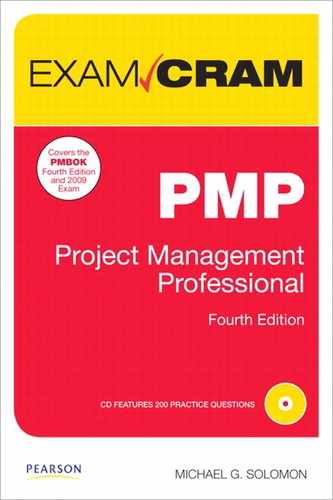Chapter 5
Understand Project Execution
In the executing process group, the work of the project takes place. The activities of the executing process group overlap with the monitoring and controlling process group (as well as the other process groups, to some extent). The specific activities that PMI identifies as part of executing are
![]() Direct and manage project execution
Direct and manage project execution
![]() Perform quality assurance
Perform quality assurance
![]() Acquire the project team
Acquire the project team
![]() Develop the project team
Develop the project team
![]() Manage the project team
Manage the project team
![]() Distribute information
Distribute information
![]() Manage stakeholder expectations
Manage stakeholder expectations
![]() Conduct procurements
Conduct procurements
Integration Management
![]() Direct and manage project execution—4.3
Direct and manage project execution—4.3
PMI includes the direct and manage project execution process within the integration knowledge area and defines the process as “executing the work defined in the project management plan to achieve the project’s objectives.” Table 5.1 shows the inputs, tools and techniques, and outputs for the direct and manage project execution process.
TABLE 5.1 Direct and Manage Project Execution Inputs, Tools and Techniques, and Outputs
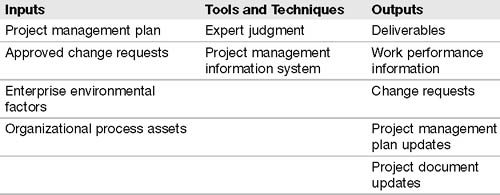
The PMBOK includes a list of activities that are included in the direct and manage project execution process. The purpose of these activities is to produce the deliverables that are defined within the project’s scope. The work also includes completed approved changes, corrective action, preventive action, and defect repair. Finally, work performance information is produced. This information is used to monitor and control activities against the project plan baseline.
One key output of this activity is the set of deliverables. They might be tangible deliverables, such as a road or computer software, or intangible deliverables such as training.
The project manager executes the project using the organization’s project management methodology and project management information system. The methodology is the tools, templates, and procedures for executing projects. For example, it includes the change management process or status reporting process.
The project management information system (PMIS) includes the scheduling tools, tools for reporting, document repositories, and any other systems used in project execution. The PMIS also includes the techniques used for gathering, integrating, and disseminating process outputs. The PMIS can be both manual and automated.
As a result of monitoring/controlling activities, additional work might be required in execution. For example, a quality control activity might indicate that a deliverable does not meet the quality standards, which would cause rework. A summary of the controlling activities, potential impacts, and resulting work is found in Table 5.2.
TABLE 5.2 Impact of Monitoring/Controlling Activities on Project Execution
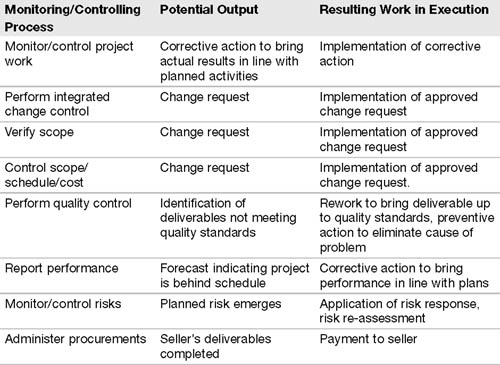
Cram Quiz
Answer these questions. The answers follow the last question. If you cannot answer these questions correctly, consider reading this section again until you can.
1. Which activity is not performed as part of the direct and manage project execution process?
![]() A. Staff, train, and manage the project team
A. Staff, train, and manage the project team
![]() B. Create and validate deliverables
B. Create and validate deliverables
![]() C. Manage risks and implement risk responses
C. Manage risks and implement risk responses
![]() D. Monitor implementation of approved changes
D. Monitor implementation of approved changes
2. You’re part of a project team constructing a manufacturing plant. You begin using process engineering to define the assumptions and constraints of the manufacturing process to be performed at the plant. This information is then used to design the major manufacturing units within the plant, which in turn serves as the starting point for designing the detailed plant layout and all other associated facilities. Next, design drawings are completed for fabrication and construction requirements. Changes and modifications occur during actual construction, requiring change control management and “as-built” documents. Finally, user acceptance testing and turnover of the completed manufacturing plant results in more adjustments and corrections. This is an example of
![]() A. Analogous estimating
A. Analogous estimating
![]() B. Assumptions analysis
B. Assumptions analysis
![]() C. Fast tracking
C. Fast tracking
![]() D. Progressive elaboration
D. Progressive elaboration
3. What does crashing a project imply?
![]() A. Project cost and project schedule tradeoffs occur to achieve the maximum schedule compression for the least cost to the project without compromising the intended scope of the project.
A. Project cost and project schedule tradeoffs occur to achieve the maximum schedule compression for the least cost to the project without compromising the intended scope of the project.
![]() B. Project cost and project schedule overruns resulting in a project coming in over budget and over time but within the original defined project scope.
B. Project cost and project schedule overruns resulting in a project coming in over budget and over time but within the original defined project scope.
![]() C. Throwing more resources at the project to meet the planned project end date and planned project scope.
C. Throwing more resources at the project to meet the planned project end date and planned project scope.
![]() D. Another term for fast tracking a project.
D. Another term for fast tracking a project.
Cram Quiz Answers
1. Answer D is correct. During the direct and manage project execution process, approved changes are implemented but monitoring of those changes is part of monitoring/controlling project work. All other activities are performed as part of direct and manage project execution.
2. Answer D is the correct response. Progressive elaboration is a technique for continuous improvement in your planning efforts. More details are added to your planning documents as the information becomes available, and each successive iteration of your planning process results in a better plan.
3. Answer A is the correct response. Crashing is a schedule compression technique whereby the project cost and project schedule are optimized to obtain the highest degree of schedule compression for the least cost to the project. Crashing does not always result in a viable project solution and can increase the overall cost of your project. Answer B is incorrect because crashing is not a term used for a project that is over time and over budget. Answer C is incorrect because crashing does not necessarily allow you to meet the planned project end date. Answer D is incorrect because fast tracking is another schedule compression tool used to perform multiple phases of project development in parallel.
Quality Management
![]() Perform quality assurance—8.2
Perform quality assurance—8.2
Quality assurance is the process of auditing quality requirements and the results from quality control measurements that are used to ensure the project employs all processes needed to meet requirements. It differs from quality control, which is monitoring specific project results to ensure they meet quality standards.
TABLE 5.3 shows the inputs, tools and techniques, and outputs for the perform quality assurance process.
TABLE 5.3 Perform Quality Assurance Inputs, Tools and Techniques, and Outputs

PMI stresses the importance of continuous improvement, which is an iterative process for improving quality. Continuous improvement is an ongoing cycle of process analysis leading to process improvements at which point further process analysis is undertaken. Process analysis is an in-depth look at what processes are being executed, how they are executed, by whom, and related processes.
Work performance information is an important input to quality assurance. Work performance information is defined as data on the status of project schedule activities. It can include such items as technical performance measurements, project deliverables status, schedule progress, and costs incurred. This information can be used in audits, quality reviews, and process analysis. Other important inputs to quality assurance include approved change requests and quality control measurements. Approved change requests are any change requests that have been processed through the change management process and approved by the proper authority. Quality control measurements are the results of quality control activities.
Along with the tools used in quality planning and quality control, two other tools in quality assurance are quality audits and process analysis. Quality audits are independent reviews to verify compliance with quality standards. For example, a review team looks at control charts to determine if the processes were being controlled properly and if proper actions were taken when processes fell outside control limits. Process analysis supports continuous improvement as explained in the previous section.
The application of quality assurance might result in changes to the project, which take the form of change requests or recommended corrective action. Updates are made to the project management plan and/or organizational process assets.
Cram Quiz
Answer these questions. The answers follow the last question. If you cannot answer these questions correctly, consider reading this section again until you can.
1. Comparing planned project practices or actual project best practices from other comparable projects to your project in an effort to improve the quality of your project and establish performance measurement baselines is called what?
![]() A. Benchmarking
A. Benchmarking
![]() B. Continuous improvement
B. Continuous improvement
![]() C. Metric creation
C. Metric creation
![]() D. Quality assurance (QA)
D. Quality assurance (QA)
2. A structured, independent review to determine if project activities adhere to your project management plan and other project documentation, including all project policies, procedures, and standards, is called a(n)
![]() A. Assurance review
A. Assurance review
![]() B. Organizational process assessment
B. Organizational process assessment
![]() C. Process analysis
C. Process analysis
![]() D. Quality audit
D. Quality audit
3. Which of the following is not one of the seven basic tools of quality?
![]() A. Cause and effect diagram
A. Cause and effect diagram
![]() B. Statistical sampling
B. Statistical sampling
![]() C. Histogram
C. Histogram
![]() D. Scatter diagram
D. Scatter diagram
Cram Quiz Answers
1. Answer A is the best response. Benchmarking is the practice of comparing your project to other planned project practices or actual project best practices in an effort to improve your project and establish performance measurement benchmarks. Answer B is incorrect because continuous improvement is a plan-do-check-act cycle for improving quality in the product developed by a project. Answer C is incorrect because metrics are specific defined tools for describing and measuring key values for quality control. Answer D is incorrect because quality assurance (QA) is the application of planned, systematic activities to achieve specific quality objectives. QA is the overarching process in which continuous process improvement is practiced. Benchmarking is one task within the process, and metrics are a way to assess quality initiatives.
2. Answer D is the correct response. A quality audit is a structured, independent review providing an assessment of whether a project’s activities meet organizational and project policies, processes, and procedures.
3. Answer B is the correct response. Statistical sampling is a quality control technique, but it is not one of the seven basic tools of quality. The seven basic tools of quality are cause and effect diagram, control charts, flowcharting, histogram, Pareto chart, run chart, and scatter diagram. Answers A, C, and D are incorrect because these items are part of the seven basic tools of quality. For more information on the seven basic tools, refer to PMBOK section 8.3.2.
Human Resource Management
![]() Acquire project team—9.2
Acquire project team—9.2
![]() Develop project team—9.3
Develop project team—9.3
![]() Manage project team—9.4
Manage project team—9.4
The project cannot be completed without people. Using the procedures defined during planning, the project manager acquires the necessary resources. Note, however, that the project manager might not have direct control over what resources are assigned to the project. When the project manager does have the ability to influence or direct staff assignments, the following should be considered:
![]() Availability—Does the person’s schedule allow them to support the project?
Availability—Does the person’s schedule allow them to support the project?
![]() Ability—Does the person have the proper skill set?
Ability—Does the person have the proper skill set?
![]() Experience—Will the project require an individual with significant experience?
Experience—Will the project require an individual with significant experience?
![]() Interest—Will the person want to work on the project, which is an important factor in motivation?
Interest—Will the person want to work on the project, which is an important factor in motivation?
![]() Cost—How much will the person cost? This can be in terms of hiring a contractor. If the resource is internal, other factors might be considered, including the effect on another project that the individual supports.
Cost—How much will the person cost? This can be in terms of hiring a contractor. If the resource is internal, other factors might be considered, including the effect on another project that the individual supports.
TABLE 5.4 shows the inputs, tools and techniques, and outputs for the acquire project team process.
TABLE 5.4 Acquire Project Team Inputs, Tools and Techniques, and Outputs

A number of tools can be used in acquiring human resources; they are summarized in Table 5.5.
TABLE 5.5 Summary of Human Resource Acquisition Tools
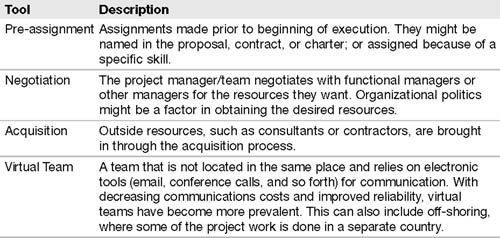
Develop Project Team
Team development has two facets; increasing the competency of the team and improving the interaction among team members. Although team development should occur throughout the project, it is most effective when conducted early in the project life cycle.
TABLE 5.6 shows the inputs, tools and techniques, and outputs for the develop project team process.
TABLE 5.6 Develop Project Team Inputs, Tools and Techniques, and Outputs
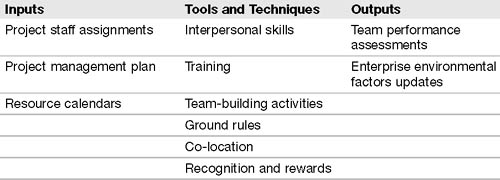
PMI lists a number of tools for team development, including general management skills, training, teambuilding activities, ground rules, co-location, and recognition and rewards:
![]() Interpersonal skills—These skills are sometimes referred to as soft skills and include empathy, creativity, influence, and group facilitation skills.
Interpersonal skills—These skills are sometimes referred to as soft skills and include empathy, creativity, influence, and group facilitation skills.
![]() Training—This is used for increasing competency. It might be formal or informal and can include classroom training, computer-based training, and coaching/mentoring.
Training—This is used for increasing competency. It might be formal or informal and can include classroom training, computer-based training, and coaching/mentoring.
![]() Team-building activities—This is any activity used to improve team cohesiveness. Teambuilding can encompass anything from a short activity at the beginning of a meeting to an offsite event. Even team participation in a project activity such as risk identification can serve to build team cohesiveness. Most teams progress through five stages of development:
Team-building activities—This is any activity used to improve team cohesiveness. Teambuilding can encompass anything from a short activity at the beginning of a meeting to an offsite event. Even team participation in a project activity such as risk identification can serve to build team cohesiveness. Most teams progress through five stages of development:
![]() Forming—This is the phase in which the team meets and first learns about the project and their roles. Team members are still independent and not yet team oriented.
Forming—This is the phase in which the team meets and first learns about the project and their roles. Team members are still independent and not yet team oriented.
![]() Storming—The team begins to consider the project work and make decisions. Collaboration is important in this phase.
Storming—The team begins to consider the project work and make decisions. Collaboration is important in this phase.
![]() Norming—Team members begin to adjust to one another, work together more closely and build trust.
Norming—Team members begin to adjust to one another, work together more closely and build trust.
![]() Performing—The team is well formed and works together well.
Performing—The team is well formed and works together well.
![]() Adjourning—The team completes project work and migrates to post-project work.
Adjourning—The team completes project work and migrates to post-project work.
![]() Ground rules—These dictate the expected behavior of the team. Having the team develop the ground rules can serve as a teambuilding activity.
Ground rules—These dictate the expected behavior of the team. Having the team develop the ground rules can serve as a teambuilding activity.
![]() Co-location—This is the opposite of virtual teams. PMI uses the team war room to describe a room where the team activities take place. Critical projects might use co-location to improve communication among team members.
Co-location—This is the opposite of virtual teams. PMI uses the team war room to describe a room where the team activities take place. Critical projects might use co-location to improve communication among team members.
![]() Recognition and rewards—These are used to motivate the team and reinforce positive behavior. The approach should be developed during planning and take into account the culture of team members, the type of behavior to be rewarded, and the budget.
Recognition and rewards—These are used to motivate the team and reinforce positive behavior. The approach should be developed during planning and take into account the culture of team members, the type of behavior to be rewarded, and the budget.
Power is an important concept within the team environment. Although the project manager is in charge, he might not have legitimate power over all team members. Other team members must also rely on some power in order to accomplish their tasks. A summary of the types of power is in Table 5.7.
TABLE 5.7 Summary of Types of Power
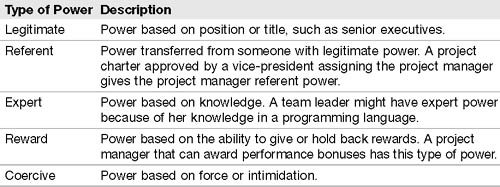
Manage Project Team
Once the project team members have been assembled and developed, they are ready for action. As the team begins the actual work of the project the focus shifts to the day-to-day management of the team. PMI addresses the task of managing the project team in the manage project team process. Table 5.8 shows the inputs, tools and techniques, and outputs for the manage project team process.
TABLE 5.8 Manage Project Team Inputs, Tools and Techniques, and Outputs
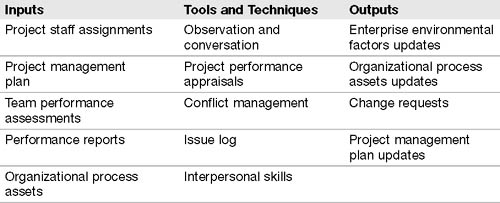
As mentioned previously, recognition and rewards are used to motivate the team. Motivation also occurs in managing the project team in the areas of interpersonal skills and conflict management. Knowledge of motivation theories is often tested in the PMP exam. A summary of the leading theories in presented in Table 5.9.
TABLE 5.9 Summary of Motivation Theories
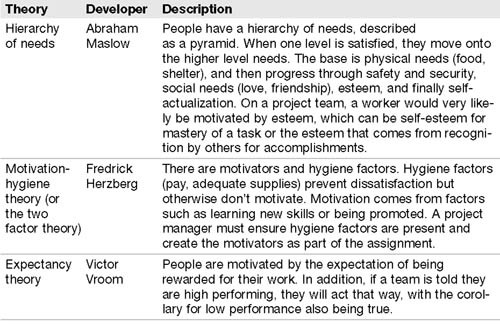
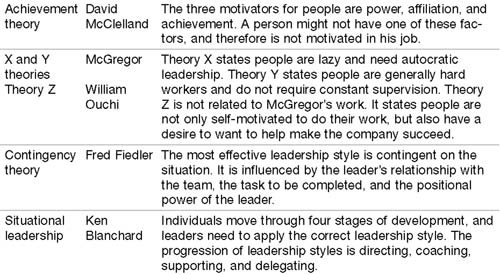
Team Formation
The theories presented in Table 5.9 focus primarily on development of individuals. PMI also discusses how the team forms as a cohesive unit. A leading theory in team development was developed by Bruce Tuckman. His theory states that teams go through stages: forming, storming, norming, and performing. He later added a fifth stage, adjourning. His model is summarized in Table 5.10.
TABLE 5.10 Tuckman’s Model on Team Formation
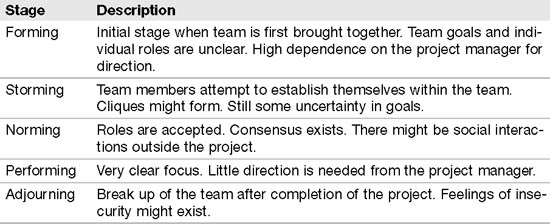
Blanchard’s situational leadership model, seen in Table 5.9, can also apply to teams. The four leadership styles can be used in Tuckman’s five stages of team development. Figure 5.1 compares these two theories.
FIGURE 5.1 Comparison of situational leadership and team formation.
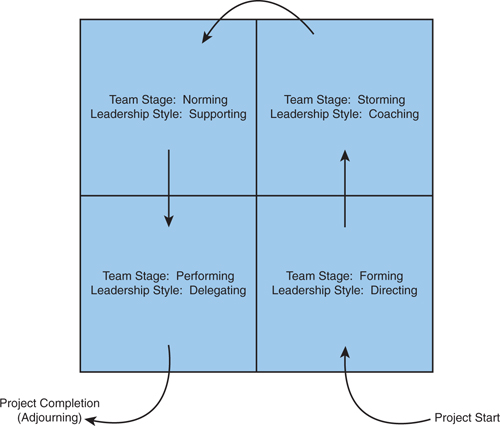
Cram Quiz
Answer these questions. The answers follow the last question. If you cannot answer these questions correctly, consider reading this section again until you can.
1. The project manager has budgeted money to provide cash awards to team members that exceed expectations. A project team member that is motivated by the chance to earn a cash reward can most accurately be explained by which theory?
![]() A. Hierarchy of needs
A. Hierarchy of needs
![]() B. Theory X
B. Theory X
![]() C. Achievement theory
C. Achievement theory
![]() D. Expectancy theory
D. Expectancy theory
2. The project is a month into the executing phase. There are some cliques forming among the team members. Which leadership style is most appropriate?
![]() A. Directing
A. Directing
![]() B. Delegating
B. Delegating
![]() C. Coaching
C. Coaching
![]() D. Supporting
D. Supporting
3. The project team is composed of team members in two countries plus a contractor team in a third country. What tool would optimize communication?
![]() A. Project schedule tool
A. Project schedule tool
![]() B. War room
B. War room
![]() C. Manual filing system
C. Manual filing system
![]() D. Extranet-based electronic document repository
D. Extranet-based electronic document repository
4. Which of the following is NOT an output of the Acquire Project Team process?
![]() A. Project staff assignments
A. Project staff assignments
![]() B. Resource calendars
B. Resource calendars
![]() C. Team performance assessments
C. Team performance assessments
![]() D. Project management plan updates
D. Project management plan updates
Cram Quiz Answers
1. Answer D is correct. The person is working hard because he expects to be rewarded. The other theories do not talk about rewards as motivators.
2. Answer C is correct. The formation of cliques occurs during the storming stage of team development. During this stage, the correct situational leadership style is coaching.
3. Answer D is correct. An electronic document repository allows all team members, regardless of location, access to the documents. Manual filing and war rooms are optimal for a project team in one location. A project scheduling tool might allow team members on a shared network to share data, but would not be helpful for a third-party team.
4. Answer C is correct. Team performance assessments is an output of the develop project team process. All other answers are valid outputs of the acquire project team process.
Communications Management
![]() Distribute information—10.3
Distribute information—10.3
![]() Manage stakeholder expectations—10.4
Manage stakeholder expectations—10.4
Communicating with the project team, and with any other stakeholders, is one of the project manager’s most important tasks. In fact, a project manager spends the majority of his time communicating. Some say as much as 90% of a project manager’s time is spent communicating. Exchanging information is the only way a project manager can know how the project is progressing. The distribute information process keeps stakeholders informed. This includes communication outlined in the communication plan as well as responding to ad-hoc requests. The communication must be both timely and accurate. Table 5.11 shows the inputs, tools and techniques, and outputs for the distribute information process.
TABLE 5.11 Distribute Information Inputs, Tools and Techniques, and Outputs

Communication management is such an elemental topic due to both its importance to the smooth operation of the project team and its complexity. The number of communication channels is an exponential relationship. See Figure 5.2 for the formula and examples for calculating communication channels.
FIGURE 5.2 Communication channels.
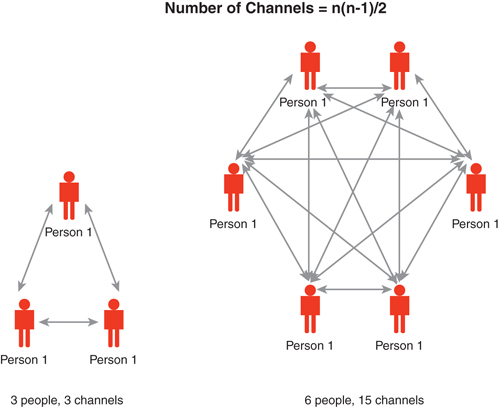
On the left side of Figure 5.2, the first team has three people (n=3), so the equation is
3*(3−1)/2=3 communication channels
On the right side of Figure 5.2, there are six team members (n=6), so the equation is
6*(6−1)/2=15 communication channels
Tools and Techniques for Distributing Information
Notice that in Table 5.11 the tools and techniques for information distribution include both communication methods and information distribution tools.
Communication Methods
Communication methods are a part of general management skills. Communication is comprised of a sender, a receiver, and the communication channel. The sender is responsible for making the message clear and accurate. The receiver is responsible for understanding the message. Communication can include the following:
![]() Written and oral
Written and oral
![]() Listening and speaking
Listening and speaking
![]() Internal and external
Internal and external
![]() Formal and informal
Formal and informal
![]() Vertical and horizontal
Vertical and horizontal
Issues can result if communications are not managed effectively on the project. For example, because email cannot easily convey emotions, an email could be sent with a comment meant to be sarcastic, but the receiver doesn’t understand that and is upset based on the content of the email. The project manager should plan out communications to avoid these types of issues, including the best method for delivering messages based on the audience and content.
If there are unique needs for information gathering and retrieval systems, they should be identified during planning. As an example, a project that involves subcontractors might need a document repository that exists outside the company’s computer network. These tools allow anyone with permission to access documents through a common web browser, even from remote locations. A summary of possible tools is provided in Table 5.12
TABLE 5.12 Information Gathering and Retrieval Tools
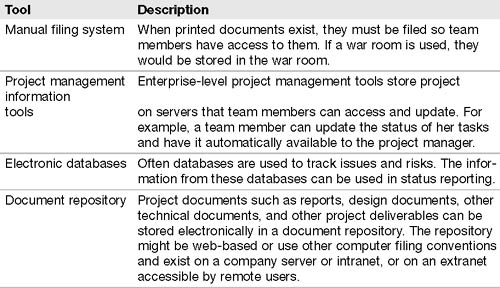
Information Distribution Tools
The project manager must ensure that information is effectively collected and distributed to project stakeholders. There are a number of tools to accomplish this:
![]() Face-to-face project meetings
Face-to-face project meetings
![]() Virtual meetings using conference bridges, web conferencing, or video conferencing
Virtual meetings using conference bridges, web conferencing, or video conferencing
![]() Distribution and filing of printed documents
Distribution and filing of printed documents
![]() Shared access to electronically filed documents and document repository tools
Shared access to electronically filed documents and document repository tools
![]() Email and fax
Email and fax
![]() Telephone and voice mail
Telephone and voice mail
![]() Access to project scheduling and other project management tools
Access to project scheduling and other project management tools
Stakeholders
A good project manager must do more than just send out timely status updates. In addition to keeping the team informed and ensuring all stakeholders have the necessary information, the project manager must also manage the impact of the information. It is important that the stakeholders remain committed to the project. One of the project manager’s jobs is to recognize and shift in stakeholder commitment and react in an effective manner. The manage stakeholder expectations process addresses that very concern. Table 5.13 shows the inputs, tools and techniques, and outputs for the manage stakeholder expectations process.
TABLE 5.13 Manage Stakeholders Expectations Inputs, Tools and Techniques, and Outputs
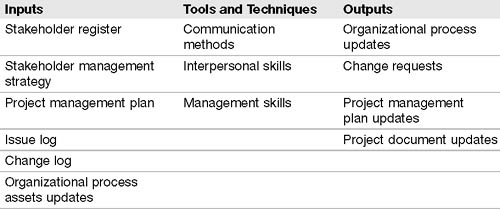
Notice that the tools and techniques exclusively address the issues of interacting with other people. That’s what managing stakeholders is all about. It is the job of the project manager to ensure all of the stakeholders continue to contribute in a material manner to the success of the project.
Cram Quiz
Answer these questions. The answers follow the last question. If you cannot answer these questions correctly, consider reading this section again until you can.
1. How many communication channels exist in a team of 20 members?
![]() A. 20
A. 20
![]() B. 80
B. 80
![]() C. 190
C. 190
![]() D. 230
D. 230
2. Communication technology factors that can affect a project include
![]() A. The urgency of the need for information
A. The urgency of the need for information
![]() B. The expected staffing on the project and the individuals’ competencies
B. The expected staffing on the project and the individuals’ competencies
![]() C. The length of the project
C. The length of the project
![]() D. All of the above
D. All of the above
Cram Quiz Answers
1. Answer C is correct. Using the formula (n)(n−1)/2, the calculation is 20*(20−1)/2.
2. Answer D is the best response. Communications technology factors include the urgency of the need for information, the expected staffing for the project, the staff members’ individual skill sets, and the length of the project.
Procurement Management
Procurement
During planning, the procurement approach is mapped out. PMI has consolidated several steps from older PMBOK editions into a single, unified process to address procurement execution issues: the conduct procurements process.
Conduct Procurements
Using the procurement management plan and other procurement documents such as the invitation for bid, statement of work, or request for quotation, developed during planning, the project team seeks out potential sellers for the items being procured. The request might be made via a bidder conference, advertising, or through the use of a qualified seller list. The most important outputs from this process are the selected sellers list, procurement contract awards, and resource calendars. Table 5.14 shows the inputs, tools and techniques, and outputs for the conduct procurements process.
TABLE 5.14 Conduct Procurements Inputs, Tools and Techniques, and Outputs
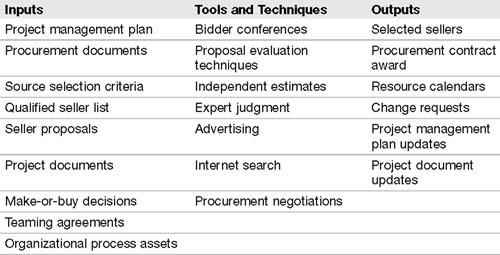
With proposals in hand, the project team must select the seller(s) that are best able to deliver the product or service. In addition to the proposals, evaluation criteria were identified during planning that are used to evaluate the proposals.
The evaluation criteria used can include any of the following:
![]() Seller’s overall understanding of the need
Seller’s overall understanding of the need
![]() Price
Price
![]() Overall life cycle cost
Overall life cycle cost
![]() History of seller with the company
History of seller with the company
![]() Seller capabilities and approach including technical, managerial, and financial
Seller capabilities and approach including technical, managerial, and financial
![]() Seller’s production capacity, business size, and interest in the product/service
Seller’s production capacity, business size, and interest in the product/service
![]() Seller’s desire to assert intellectual property or proprietary rights on the product or service.
Seller’s desire to assert intellectual property or proprietary rights on the product or service.
![]() References
References
PMI lists other inputs with which you should be familiar, including the procurement management plan, procurement policies, the procurement document package, proposals, qualified seller list, and the project management plan.
Conduct Procurements Tools
There are a number of tools used during seller selection, which are summarized in Table 5.15.
TABLE 5.15 Conduct Procurements Tools
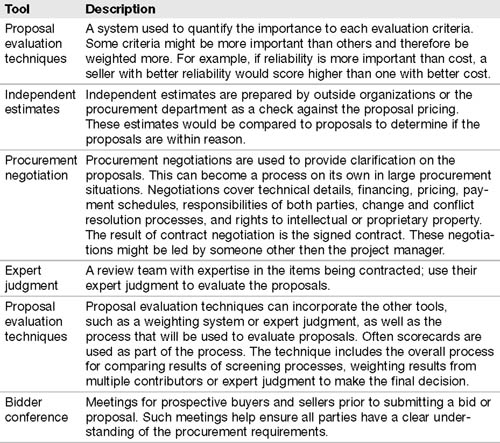
The proposal evaluation technique should be able to take into account both objective and subjective criteria. The technique incorporates the weighting system for the evaluation criteria. The proposal evaluation is conducted by multiple reviewers. An example of a proposal evaluation scorecard is shown in Table 5.16. In this example, Vendor Two had the higher score and would be selected as the seller.
TABLE 5.16 Sample of Proposal Evaluation Scorecard

The weighting system is developed based on the criteria that the organization determined was important for the project. In Table 5.16, price received the highest weight, while experience received the lowest weight. Using that scorecard, a vendor with a lower price receives a higher weighted score then a vendor with significant experience. The raw scores are determined by the individuals or team reviewing the proposals.
The weighting system can be used to either select a final seller or to prioritize the list of sellers for contract negotiations. If a satisfactory contract cannot be arranged with the seller receiving the top score, contract negotiations could begin with the next seller.
Cram Quiz
Answer these questions. The answers follow the last question. If you cannot answer these questions correctly, consider reading this section again until you can.
1. During the process of selecting the sellers, the project manager rejects one vendor because it doesn’t have the necessary manufacturing capability. This is an example of which selection tool?
![]() A. Weighting system
A. Weighting system
![]() B. Expert judgment
B. Expert judgment
![]() C. Seller rating system
C. Seller rating system
![]() D. Screening system
D. Screening system
2. Which technique for selecting a seller is useful when there are several differences between the sellers and no clear “best choice”?
![]() A. Weighting system
A. Weighting system
![]() B. Expert judgment
B. Expert judgment
![]() C. Seller rating system
C. Seller rating system
![]() D. Screening system
D. Screening system
Cram Quiz Answers
1. Answer D is correct. A screening system rejects sellers that don’t meet minimum requirements.
2. Answer A is the best answer. While Answers B, C, and D could be viable choices, only a weighting system allows for easy comparison of sellers when multiple variables are involved.
What Next?
If you want more practice on this chapter’s exam topics before you move on, remember that you can access all of the Cram Quiz questions on the CD. You can also create a custom exam by topic with the practice exam software. Note any topic you struggle with and go to that topic’s material in this chapter.
